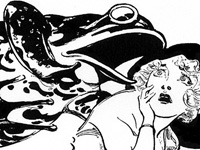Alien Invasions
America's wildlife looks different than it did before Columbus: Newcomers to North America introduced many plants and animals. Some introductions were accidental, but others were made to "improve" the New World.
In each pair of species, one is native to America and one was introduced. Select the introduced species:
1. House Sparrow (Passer domesticus), first introduced by the New York-based American Acclimatization Society in the 1850s, and by others during that decade.
2. Starling (Sturnus vulgari), first introduced by Eugene Schieffelin of the American Acclimatization Society into Central Park in 1877.
3. Rock Pigeon (Columba livia), first introduced to North America in 1606 at Port Royal, Nova Scotia.
4. Kudzu (Pueraria lobata), first introduced on a large scale to America from about 1935 by the Soil Conservation Service and the Civilian Conservation Corps, which planted it extensively in southern states in an effort to control soil erosion.
5. Dandelion (Taraxacum officinale), first introduced by British colonists as a garden green and medicinal herb.
6. Common Carp (Cyprinus carpio), first brought to the U.S. in 1831, but widely introduced by U.S. Fish and Fisheries Commission head Spencer Fullerton Baird soon after 1871, as a food source in the nation's overfished rivers and lakes.
7. Water Hyacinth (Eichhornia crassipes), first introduced into North America in 1884. It now clogs many lakes, ponds, and inland waterways.
8. Gypsy Moth (Lymantria dispar), introduced to Medford, MA, in 1868, by French amateur entomologist Étienne Léopold Trouvelot, in an effort to cross breed them with silk moths in the U.S., which had become susceptible to various diseases.
 The University of Georgia's Center for Invasive Species and Ecosystem Health lists invasive species—plants, animals, insects, and others—in the U.S. today. It does not, however, describe the history of most invasions—a classroom exercise might involve students selecting a species from the list and tracing its introduction to the U.S. through research elsewhere. For instance, the New York Times' archived articles include an 1877 article on the American Acclimatization Society's release of sparrows, skylarks, and other birds in North America.
The University of Georgia's Center for Invasive Species and Ecosystem Health lists invasive species—plants, animals, insects, and others—in the U.S. today. It does not, however, describe the history of most invasions—a classroom exercise might involve students selecting a species from the list and tracing its introduction to the U.S. through research elsewhere. For instance, the New York Times' archived articles include an 1877 article on the American Acclimatization Society's release of sparrows, skylarks, and other birds in North America.
Try a general search of NHEC using the keywords "Civilian Conservation Corps" to learn more about the history and activities of this New Deal organization.
For websites offering primary sources and high-quality information on the environment, conservation, and other ecology-related topics in U.S. history, search NHEC's Website Reviews—Topic: Environment and Conservation. Or search Online History Lectures using the same topic to turn up audiovisual presentations, long and short, on nature and U.S. history.
- Peter Coates, American Perceptions of Immigrant and Invasive Species: Strangers on the Land (Berkeley: University of California Press, 2006).
- Edward Hicks, Peaceable Kingdom, c. 1834.
- T. S. Palmer, "The Danger of Introducing Noxious Animals and Birds," Forest and Stream, June 1899, 443-444.


